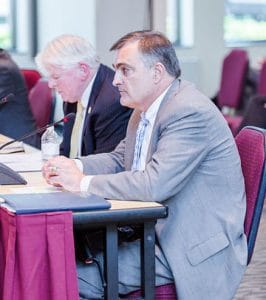Add this occurrence to thousands just like it – examples of why two crew members are absolutely necessary to safely operate a locomotive. In a recent news story from NBC Montana, both crew members worked to disengage cargo cars, effectively stopping the fire from spreading and averting a potential disaster. No injuries were reported. Read the complete story here.
Tag: FRA
 The Columbus Dispatch reported that the issue of crew consist has railroads at odds with federal regulators. This comes after the Federal Railroad Administration announced a proposed rule earlier this year requiring two-person crews on trains.
The Columbus Dispatch reported that the issue of crew consist has railroads at odds with federal regulators. This comes after the Federal Railroad Administration announced a proposed rule earlier this year requiring two-person crews on trains.
Standing with the FRA, and this rule, are railroad employees, their unions and the public.
SMART TD National Legislative Director John Risch told the Columbus Dispatch, “Today, the only safe way to run a train is with two crew members. I would quit my job before I went out there by myself.”
Click here to read more from the Columbus Dispatch.
The Federal Railroad Administration (FRA) announced a Finding of No Significant Impact on the Northern New England Intercity Rail Initiative (Initiative). This will enable states in the New England region, in partnership with the federal government, to develop plans for and invest in new passenger rail service. Read the complete press release here.
On Friday, July 15, John Risch, National Legislative Director with SMART TD, testified before the Federal Railroad Administration (FRA) in Washington, DC, in strong support of a minimum two-person crew mandate for freight and passenger trains. It may take months for the FRA board to make a final decision. Read his complete testimony here. Front page photo: Risch at FRA hearing.

Senator Heidi Heitkamp (D-ND) testified in today in hearings before the FRA, in support of a two-person crew rule for all freight trains. Seated directly behind the Senator is John Risch, SMART TD Legislative Director. Risch, SMART TD Member Mike Rankin, and TTD President Ed Wytkind also provided testimony in favor of the rule.
Along with Senator Heidi Heitkamp (D-ND), leaders and members of transportation unions, including TTD and SMART TD, provided compelling testimony to the FRA today, in support of a federal rule that would mandate a minimum of two crew members for all freight train operations. Read the complete TTD press release here
SMART Transportation Division President John Previsich and Brotherhood of Locomotive Engineers and Trainmen (BLET) President Dennis Pierce, issued a joint statement, following their submission of their comments to the Federal Railroad Administration (FRA) on train crew size.
“Operating freight trains with one-person train crews is unsafe and must be prohibited. That is the message we delivered yesterday in the comments filed with federal rail safety regulators,” Previsich and Pierce said.
“Our comments provide a clear rationale for the FRA to finalize a rule this year and to close loopholes included in the agency’s initial proposed rule that could permit the limited use of one-person crew freight operations.”
Click here to read the official press release from both unions.
Click here to read the comments submitted to the FRA, followed by the polling results of 11 individual states on two-person crews conducted by DFM Research on behalf of SMART TD (see page 18 for polling results).
On Wednesday, June 15, SMART Transportation Division and the Brotherhood of Locomotive Engineers and Trainmen (BLET) submitted their joint comments on the Federal Railroad Administration’s (FRA) proposed two-person crew rule.
While both unions strongly support the proposed rule, they suggested in their comments that the rule be made stronger before being made final.
“We firmly believe that the only safe way to operate a train is with a crew of at least two people – a federally certified locomotive engineer and a federally certified conductor,” the unions emphasized.
Click here to read the unions’ comments. Following the comments (on page 18) are the polling results of 11 individual states on two-person crews conducted by DFM Research on behalf of SMART TD.
Members, family, friends and communities can comment on the proposed rule until tonight at 11:59 p.m. eastern time and are encouraged to do so. Click here to comment.

May an employee wear a device like a “Garmin Vivofit” or “Fitbit” wristband that acts like a watch, and counts the steps that an individual takes each day? The devices are not searching for the internet, or Wifi, to do this and must be synchronized with Bluetooth on a separate device. The devices are essentially digital watches and track the number of steps an individual takes each day in the background. Does the FRA consider these devices “smart watches”?
FRA considers Fitbits and similar devices to be “personal electronic devices” that are subject to the restrictions in part 220. Per the definition of an “electronic device” at 49 CFR 220.5, they are an electronic device that performs functions not necessary for the health or safety of that person and entail the risk of distracting employees from safety-related tasks.
FRA understands some Fitbit devices are rather limited in their functionality. However, a number of different fitness tracking devices are available. The Fitbit Blaze, for example, has functions that include mobile playlists, call alerts, text alerts and fitness tracking. These functions are the same type of distracting functions that have caused railroad accidents and were the impetus for the restrictions contained in part 220.
The regulation text of part 220 does not distinguish between Fitbits that have limited functionality, and those that are more akin to smartphones or smartwatches. Unless a waiver granting an exemption for certain fitness tracking devices with limited functionality were issued by FRA in the future, the agency considers all such devices to be “personal electronic devices” that are subject to the restrictions in part 220. However, railroad operating employees are allowed the use of digital clocks or wristwatches whose primary function is to tell time.
Timepieces are commonly used in the railroad industry to verify the accuracy of a locomotive’s speed indicator. This function is safety-related in that it accurately allows a train crew to comply with relevant track speed limits during the course of a train’s movement. This exception is limited to those wristwatches that do not have functions which violate the requirements set forth under 220 subpart C. The Primary function of fitness tracking devices is not to tell time.
As stated in Title 49 CFR 220.303, a railroad operating employee shall not use an electronic device if that use would interfere with the employee’s or another railroad operating employee’s performance of safety-related duties. No individual in the cab of a controlling locomotive shall use an electronic device if that use would interfere with a railroad operating employee’s performance of safety-related duties.
The exceptions within 220 subpart C account for varying operating situations, with particular flexibility for railroad supplied devices.
The only exceptions within 220 subpart C are specially stated in § 220.309:
§ 220.309 Permitted uses; exceptions to other restrictions.
Notwithstanding any other limitations in this subpart, a railroad operating employee may use the following, if that use does not interfere with any employee’s performance of safety-related duties—
(a) The digital storage and display function of an electronic device to refer to a railroad rule, special instruction, timetable, or other directive, if such use is authorized under a railroad operating rule or instruction.
(b) An electronic device as necessary to respond to an emergency situation involving the operation of the railroad or encountered while performing a duty for the railroad.
(c) An electronic device to take a photograph of a safety hazard or a violation of a rail safety law, regulation, order, or standard, provided that—
- A camera that is part of a cell phone or other similar multi-functional electronic device is not included in this exception unless it is a railroad supplied device and is used for an authorized business purpose;
- The camera, unless otherwise permitted, is turned off immediately after the documentation has been made; and
- If the camera is used in the cab of a moving train, the use is only by a crewmember other than the locomotive engineer.
(d) A stand-alone calculator if used for an authorized business purpose.
(e) A medical device that is consistent with the railroad’s standards for medical fitness for duty.
(f) A wireless communication device to conduct train or switching operations if the railroad operating employee is part of a crew assigned to a train that is exempt under § 220.9(b) from the requirement of a working radio when the employing railroad has fewer than 400,000 annual employee work hours.
Additionally, railroads may impose more stringent requirements that are subject to change at the railroad’s discretion, without notice to FRA, and can vary from railroad to railroad.






